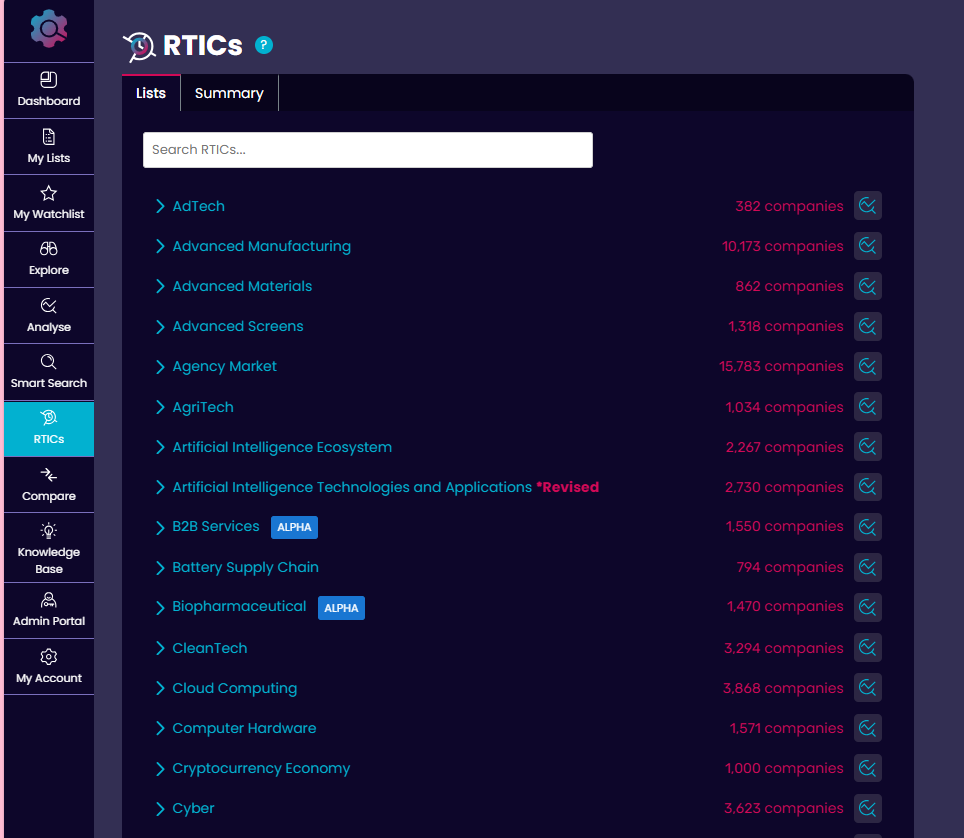In the tech world, things are constantly changing and at The Data City that is no different.
We have recently begun launching Alpha RTICs. In this blog we’ll be explaining what they are and what they do and show you one of the newest Alpha RTICs!
If you’re new here, or you need a reminder our ‘Real Time Industrial Classifications’ (RTICs) are The Data City’s evolution of Standard industrial classifications (SICs). Our RTICs provide a clearer, up-to-date view of who’s active in what sectors, where they’re based, and how they’re performing. You can find out more here.
What is an Alpha RTIC?
At The Data City we build our RTICs with industry experts of the relevant sector, be that: Government Agencies, Trade associations, Think Tanks or prominent market leading companies. Find out how we do that here.
An Alpha RTIC is when our Industry Analysts build an RTIC without a relevant industry expert. We’ve started doing this because we believe certain industries need to be properly mapped to gain the visibility they deserve, helping them receive the recognition and support they need.
Alpha RTICs are our first draft maps of each sector, they’re a starting point, not the finished product. They give a view of the main players while we gather deeper industry insight. When an expert sponsor comes on board, we’ll update each RTIC with their input to build a complete, accurate taxonomy.

Our first Alpha RTIC: PropTech
Technology is reshaping almost every industry, and real estate is no exception. The rise of PropTech (Property Technology) is transforming how we buy, sell, rent and manage property.
From building management platforms and smart buildings to interactive 3D models, virtual viewings and AI-driven investment tools, PropTech is making processes faster, more transparent and more efficient. In short, it is helping property professionals, investors and tenants alike to get more value from the spaces they use and manage.
Our Industry Analysts have worked hard to map out the PropTech sector so that we can show you one of the UK’s newest frontier sectors! This sector was identified to have four clear verticals (sub sectors); Let have a look at them.
Construction and Development
This vertical includes technology companies that support the planning, design, and delivery of real estate and infrastructure projects.
Property Management and Leasing
This vertical looks at companies using technology to enhance and streamline various aspects of managing real estate, from buying and selling to tenant interactions and property operations. This includes digital tools, software, and platforms designed to optimise workflows, improve efficiency, and enhance tenant experiences.
Real Estate Investment Tech
This vertical look at companies that leverage digital tools and solutions to enhance various aspects of the real estate investment process, such as research and analysis.
Smart Buildings and IoT
Smart buildings, powered by the Internet of Things (IoT), are transforming the PropTech sector by enhancing efficiency, sustainability, and occupant well-being. These buildings utilise connected sensors, devices, and software to collect and analyse data, optimising operations and creating more comfortable, secure, and sustainable spaces.
RTIC Summary

Above is a snapshot of the RTIC with all the top line stats. This shows just how important it is that the frontier economy is mapped. Without it, if it was just under the SIC code system this £16 billion industry would not be captured and the companies in it would not get the visibility needed to help propel themselves to the next level and by extension the UK economy to the next level!
The Data City is actively solving this problem and at pace though our expert partners and our Alpha RTICs.
You can have a deeper look at the PropTech RTIC here.
Want to discover more?
With The Data City, you can explore the PropTech sector in real time – with accurate classifications, funding data, location mapping and growth insights.
Sign up for a free trial and see the data for yourself today.
Please note: The data from The Data City is accurate at the time the article was written but may change over time due to the dynamic, real-time nature of our data. For the latest insights, visit our platform.


